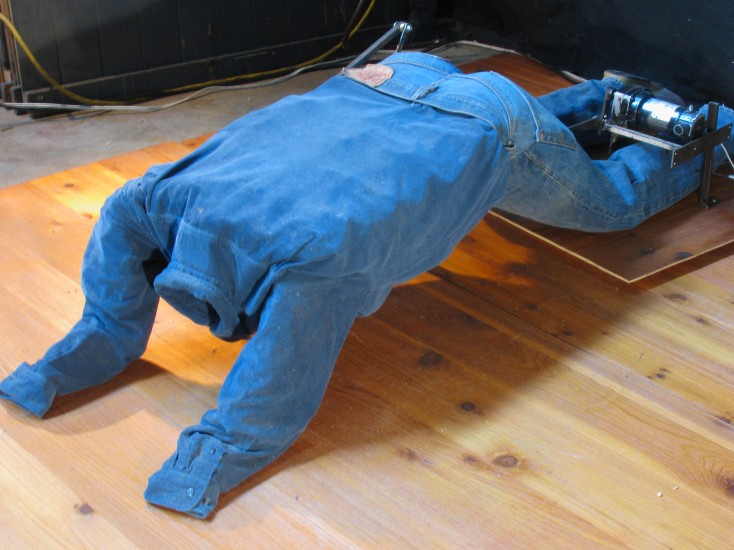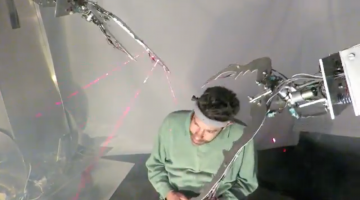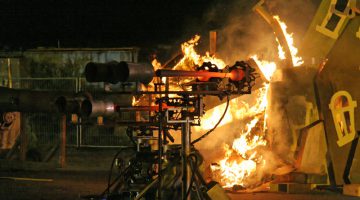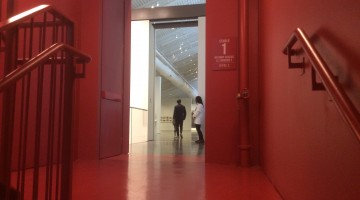Kal Spelletich
Intention Machines
April 11 – May 23, 2015
Catharine Clark Gallery
248 Utah Street, San Francisco, CA 94103
(Saturday, April 11: Opening reception with the artist, 5:00 – 7:00 pm. This event is free and open to the public.)
The ideas of the intending mind and visual perception were the two key components of Turing’s first computer. Yet intentionality was always located in the domain of the mental or intellectual. By extension, robots, whose behaviors in the technological field remain constrained by the forever-and-a-day rhetorical question, “Will artificial intelligence ever catch up to human intelligence?” still flounder in Turing’s intentional theoretical impasse. “But where is the body, where is the soul?” is a question artist Kal Spelletich has been asking of the robot for over four decades. By trying to reconcile the gap in intentional systems science with sculptures that challenge and upend the human intelligence and artificial intelligence divide, Spelletich looks to the messy realm of “intentional imperfection” to keep machines and humans, human. In other words, we may know what is best for us, or what “we are programmed to do,” but we freely disobey our bodily instinct and intuition on countless occasions while artificial intelligence simply fulfills what it is designed to do. Spelletich thinks about robots as they would think about “themselves,” and creates machines that may fully justify our adoption of the intentional stance resulting in the optimistic possibility that technology treat us more humanely.
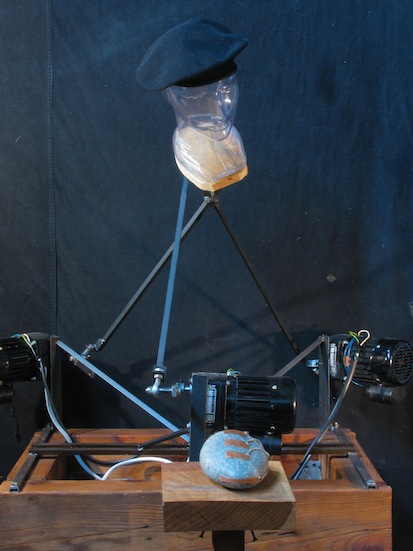
Kal Spelletich. “Lawrence Ferlinghetti,” 2015. Robot, clothes, electronics, mannequin, steel. H: 6′ 6.5″ W: 2′ 8″ L: 2′
For over four decades, we have watched Spelletich make post-apocalyptic kinetic sculptures, feasting on leftover Silicon Valley debris, scavenged or reclaimed “free” technology, outmoded computer hardware, and detritus, which he calls “Obtanium.” We have encountered his menacing mechanized fire-breathing creatures made from welded metal and scrapped computer parts while he was affiliated with Survival Research Lab, pyrotechnics, and his own interactive machine art performance collective SEEMEN, founded in 1988. We have even had the opportunity to operate Spelletich’s intense, dangerous machinery in real-time, interacting with contraptions against our higher instincts for self-preservation. We have run in fear from the San Francisco mad-scientist’s widely acclaimed fire-ensconcing robotic art, which brought us too close to the dystopian realities of our real world–where art and life collide in anxiety-provoking, sensory rabbit-holes in which technology and terror machines run amok. If Spelletich’s past warning to us had been something like a satirical “No one gets out alive,” today his work might feel more like an authentic “Let’s get together to humanize machines through a spiritual communal awareness.” Now hugging and praying robots and small elegant aura reading machines are his studio-mates.
This is not to say that Spelletich has stopped messing with our machines, bodies and minds, and our method of attributing belief, desires and rational acumen to technology. He has not stopped critiquing technology while honoring and mastering it. He has certainly not stopped questioning the alarming promise that new advances in information and communication technologies will solve social and global problems and fulfill our private and public dreams. That is his work as an artist and activist with the conviction that the robot must first be shown to possess a particular moral status before it is a candidate for having genuine intentionality. People automatically think in terms of intentions—to us it is obvious. Machines, however, must be instructed to think in these terms. “What properties must a machine have if it is to have genuine beliefs about objects in the world the way humans find nurture and meaning in day to day objects?” asks Spelletich with vision. In some ways, his work points to a second or meta-order of intentional systems that is certainly more sophisticated; can robots have beliefs and desires (and no doubt other intentional states) about beliefs and desires? What is the machine’s moral or metaphysical status and what properties must a machine have if it is to have genuine beliefs about objects in the world? “We may think all we need to do is update, upgrade and replace our devices,” adds Spelletich with genuine concern, “but we can’t just upgrade ourselves to enlightenment, right?”
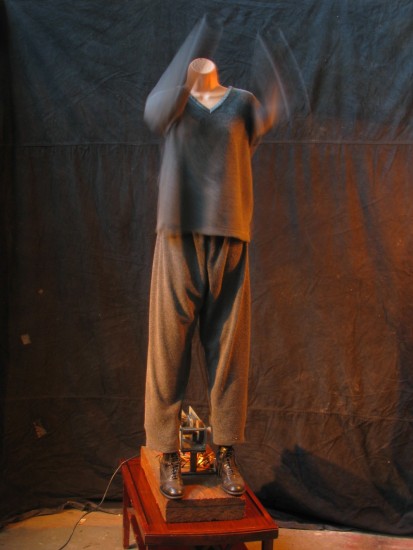
Kal Spelletich. “Martha Wilson 2014-2015,” Robot, clothes, electronics, sensor, coffee table, steel. H: 7′ ; W: 3′ ; L: 4′. Courtesy of Catharine Clark Gallery.
This particular thread of inquiry brings us to Spelletich’s new exhibition at Catharine Clark Gallery, opening mid-April, that is accompanied by a series of collaborative public programs and performances—as is Kal’s artist community tradition. Intention Machines features seven headless robots—avatars of friends, mentors, heroes and sheroes who have profoundly influenced the artist’s life. This is the first time Spelletich has turned to machine portraiture, biography, or the person machine person. In this exhibition, mechanical models genuflect, clasp hands in prayer, and whirl like Sufi dervishes. Sensors on the robots are programmed to detect a variety of inputs: proximity, touch, force, breath-alcohol content, polygraph metrics, and ambient sound. Responses are spontaneous and unique—the robots have no stored memory. Each of the photographs in the exhibit relates to the same individuals personified by the robotic sculptures. Here’s the list of the seven characters in Intention Machines, in Kal’s own words:
Kay Miller:
Artist, teacher I studied under in the early 1980’s at the University of Iowa. Kay Miller creates works that coalesce disparate epistemologies reflective of her experience as a Métis and Comanche woman raised in the poverty-stricken urban ghettos of Houston, Texas. Inspired from her study of Zen Buddhism, Karma Yoga and I Ching.
Kay’s robot spins as a whirling dervish, she can go quite fast and reverse direction on a dime.
Chris Johanson:
Aritst, friend, collaborator.
Chris’s robot does a jig/dance with some special hand and stomach actions….
Martha Wilson:
Arts promoter, artist, mentor, Shero. New York feminist performance artist. She is the founding director of Franklin Furnace. Franklin Furnace Archive, Inc. is an arts organization based in Brooklyn, New York that serves to preserve and encourage the production of avant-garde art, particularly forms that are under-represented by arts institutions due to their ephemeral nature or politically unpopular content. Martha’s robot slowly raises her hands to the sky clasping, then lowering.
Mark Pauline:
Artist, founder and proprietor of Survival Research Laboratories
Dangerous and Disturbing Mechanical Presentations Since 1979
I started working with Mark in 1990 and still do.
This is a Praying robot with the clothes (work coveralls) of Mark Pauline a friend, colleague and mentor. It is on it’s knees and leans forward onto all fours and then back upright onto his knees with his arms stretched up. He is on a coffee table.
Emory Douglas:
Artist, Minister of Information, The Black Panther Party.
Emory worked as the Minister of Culture for the Black Panther Party from 1967 until the Party disbanded in the 1980s. His graphic art was featured in most issues of the newspaper The Black Panther (which had a peak circulation of 139,000 per week in 1970). Douglas has, “branded the militant-chic Panther image decades before the concept became commonplace. He used the newspaper’s popularity to incite the disenfranchised to action, portraying the poor with genuine empathy, not as victims but as outraged, unapologetic and ready for a fight.”
This is a genuflecting robot with the actual (work) clothes of friend and mentor Emory Douglas that genuflects (kneels) and stands back upright.
Les Blank:
Documentary Filmmaker
Les was a brilliant filmmaker and friend. His films on US folk culture changed my views of art and life. I am close with his son who is my age.
Les’s robot prostrates himself onto the floor flat, then gets back up to his hands and knees.
Lawrence Ferlinghetti:
What do you say about Lawrence, he went to the Supreme Court and won defending free speech and artists rights. A true warrior, anti-war pro people a constant voice for the left since before I was born.
Lawrence’s beret does a chaotic head nod/tip in a very random unpredictable way with ridiculous 3 Horse Power of strength.
This new path—Kal’s newest robots, his friends—are not out of control but instead, as he describes, “they are purposeful, filled with meaning, and intimate. They are made from clothing and details given to me from the subjects themselves.” These elements are authentic, tangible, nostalgic, second-hand, touched by both effigies and the human subjects—literally humanizing technology. Perhaps the artist’s new message is less cynical than before: maybe the apocalypse is further away and maybe, thanks to poetic kinetics and mystical machines, the world might actually not be so scary.
*all quotes from a conversation with the artist on March 15, 2015
—
Additionally: Several special collaborative events will take place as part of Spelletich’s exhibit. On Saturday, May 2, from 7 – 10 pm, artMRKT San Francisco will co-host an after-party at Catharine Clark Gallery in conjuction with the art fair festivities at Fort Mason. Kal Spelletich will join with artist-musicians Scott Hewicker, Alicia McCarthy and Paul Kos for a night of DJ’d music and cocktails poured by Spelletich’s robots. On Thursday, May 14, from 5 – 7 pm, Spelletich and Alistair Shanks, a Buddhist chaplain who has worked with the Zen Hospice Project and in the San Francisco County Jail system, will give a talk entitled, “Robots and Mystical Transformations: Can Technology Help Address Spiritual Questions and Crises?” An electric array of music DJ’d by Shanks and Spelletich will follow. The exhibit will close on Saturday, May 23 with a musical performance from 3 – 5 pm featuring Spelletich’s robots, as well as Bay Area painter, street artist and performer Chris Johanson who will make a special guest appearance at the turntables.
